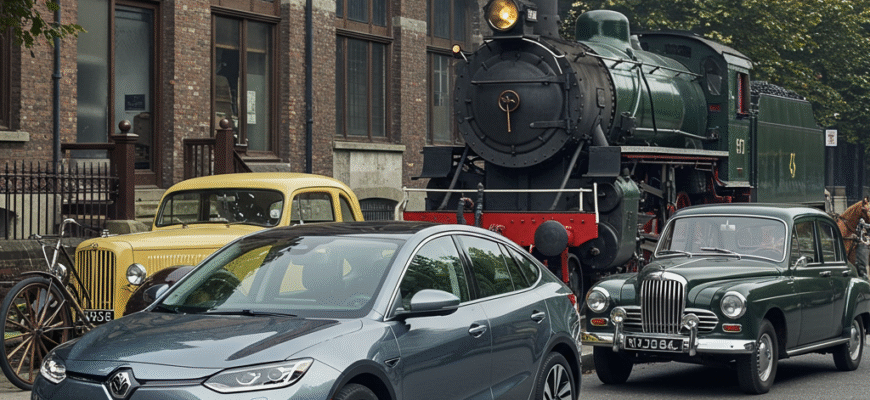Content
The Dawn of Mechanical Might: Steam Power Unleashed
For millennia, transportation relied on muscle power – human or animal – supplemented by the wind for sailing. While ingenious carts, chariots, and ships were developed, speed and range remained severely limited. The real revolution began quietly, in the workshops and mines of the 18th century, with the harnessing of steam. Initially developed to pump water out of mines, the steam engine’s potential for propulsion soon became apparent. Early experiments were often clumsy and dangerous, but pioneers like James Watt significantly improved engine efficiency. This paved the way for its application beyond stationary tasks. The early 19th century witnessed the birth of steam-powered locomotion, forever changing land travel. Richard Trevithick’s early locomotives, though rudimentary, demonstrated the principle. George Stephenson’s “Locomotion No. 1” and later, the famous “Rocket,” cemented the railway’s future. Suddenly, overland travel wasn’t measured in days or weeks, but in hours. Goods could be moved in bulk far faster and cheaper than ever before via canals or horse-drawn wagons. This spurred industrial growth, connected communities, enabled the rise of commuting, and fundamentally altered the geographical landscape with ribbons of iron track spreading across continents.George Stephenson’s “Rocket,” built in 1829, is often hailed as a pivotal moment. It won the Rainhill Trials, a competition to determine the best locomotive design for the Liverpool and Manchester Railway. Its advanced design features set the standard for steam locomotives for decades to come, proving their viability for reliable passenger and freight service.Steam power didn’t just conquer land; it revolutionized sea travel too. While sailing ships relied on unpredictable winds, steamships offered scheduled services and greater reliability. Robert Fulton’s “Clermont” demonstrated the feasibility of commercial steamboat travel in 1807. Over time, improvements in engine design and the shift from paddle wheels to screw propellers made ocean voyages faster and safer, shrinking the perceived size of the world and facilitating global trade and migration on an unprecedented scale.
The Internal Combustion Engine: Personal Freedom and a Changing World
While steam reigned supreme for much of the 19th century, another technological marvel was brewing: the internal combustion engine (ICE). Lighter, more compact, and potentially more powerful for its size than steam engines, the ICE promised a new kind of mobility. Early pioneers like Nicolaus Otto developed the four-stroke engine, while Karl Benz is credited with creating the first practical gasoline-powered automobile in 1886, the Benz Patent-Motorwagen. The early automotive era was one of experimentation and luxury. Cars were expensive, unreliable “horseless carriages,” affordable only to the wealthy. They were seen more as novelties than practical transportation. That perception dramatically shifted thanks to pioneers like Henry Ford.Mass Production and the Automobile Age
Ford didn’t invent the automobile, but he democratized it. His introduction of the moving assembly line for the Model T in 1913 slashed production times and costs. This made the car affordable for the average American family, transforming it from a luxury item into an essential tool. The ripple effects were enormous:- Urban Sprawl: People could live further from city centers, leading to the growth of suburbs.
- Infrastructure Development: A massive expansion of roads, highways, gas stations, and motels was required.
- Economic Growth: The automotive industry became a major economic driver, creating jobs in manufacturing, oil, rubber, steel, and services.
- Cultural Impact: The car symbolized freedom, independence, and the open road, deeply embedding itself in popular culture.
Refinement and the Jet Age
The mid-20th century saw continuous refinement of ICE technology in cars, making them faster, more comfortable, and more reliable. The development of the jet engine during World War II, however, brought about another leap in transportation speed, primarily impacting aviation. The post-war era ushered in the Jet Age. Aircraft like the Boeing 707 and Douglas DC-8 drastically cut flight times, making international travel accessible to a broader public and further integrating the global economy. Road networks also continued to expand globally, with vast interstate and motorway systems facilitating efficient trucking and personal travel. The ICE remained the undisputed king of personal and commercial ground transportation for decades.The Electric Revolution: A Shift Towards Sustainability
Despite the dominance of the internal combustion engine, its environmental impact became increasingly apparent throughout the latter half of the 20th century. Concerns over air pollution, greenhouse gas emissions, and reliance on finite fossil fuels spurred research into alternative propulsion methods. Interestingly, electric vehicles (EVs) are not a new concept; they competed with gasoline and steam cars in the early days of the automobile but lost out due to the limitations of early battery technology and the rapid advancement of the ICE. The late 20th and early 21st centuries saw a resurgence of interest in EVs, driven by environmental regulations and significant improvements in battery technology, electric motor efficiency, and power electronics. Hybrid vehicles, combining a small ICE with an electric motor, served as a transitional technology, improving fuel efficiency and introducing drivers to electric propulsion.The Rise of Modern EVs
The launch of vehicles like the Tesla Roadster in 2008 and the Nissan Leaf in 2010 marked the beginning of the modern EV era. These weren’t just niche experiments; they were practical cars offering reasonable range and performance. Since then, the market has exploded:- Battery Advancements: Lithium-ion batteries have become lighter, more energy-dense, and cheaper, enabling longer ranges.
- Charging Infrastructure: While still developing, networks of public charging stations are expanding rapidly.
- Performance: Electric motors offer instant torque, resulting in quick acceleration and a smooth, quiet driving experience.
- Variety: Almost every major automaker now offers or is developing electric models, from small city cars to large SUVs and trucks.









